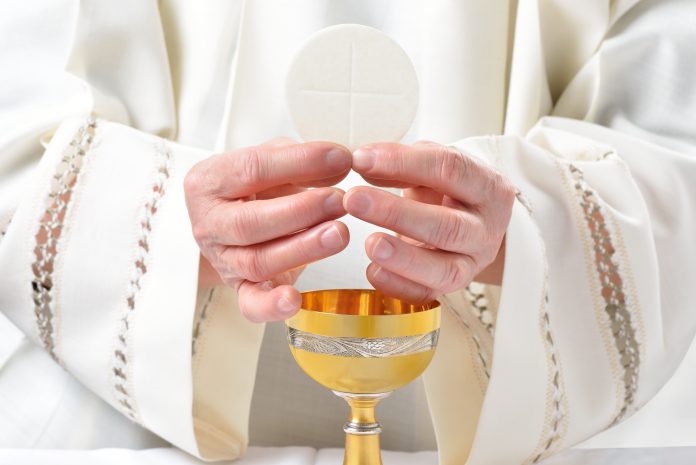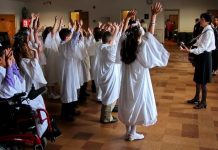
by William P. Roberts, Ph.D.
They were confused, those two disciples, as they wended their way to Emmaus, seven miles from Jerusalem. As they were discussing what had transpired the past few days, the Risen Christ, as yet unrecognized, came and walked by their side. He recalled for them the Scriptures to help them understand why he should suffer and die before entering into his glory.
When they drew near to where they were going, the disciples urged the stranger to stay with them. “And it happened that, while he was with them at table, he took bread, said the blessing, broke it, and gave it to them. With that their eyes were opened, and they recognized him but he vanished from their sight.” Then they commented to each other, “Were not our hearts burning within us while he spoke to us on the way, and opened the scriptures to us?” They then immediately returned to Jerusalem to spread the Good News (Luke 24:13-35; quotations, vv. 30 and 32; all Scripture quotations in this article are taken from the New American Bible).
Christ Present Today
This familiar post-Resurrection narrative in which Christ relates to these disciples through Scripture and the breaking of the bread serves as an appropriate background for reflecting on how Christ continues to communicate himself to us as Word and as Eucharist. Before we begin this reflection, it is important to situate Christ’s presence in the Eucharistic liturgy in the context of the many other ways in which he is present to us today.
Elaborating on Vatican II’s treatment of this topic (Sacrosanctum Concilium, n. 7), Pope Paul VI, in his encyclical on the Eucharist (Mysterium Fidei) states: “Christ is present in His Church when she prays, since He is the one who ‘prays for us and prays in us and to whom we pray…;’ and He is the one who has promised, ‘Where two or three are gathered together in my name, I am there in the midst of them.’ He is present in the Church as she performs her works of mercy, not just because whatever good we do to one of His least brethren we do to Christ Himself, but also because Christ is the one who performs these works through the Church and who continually helps men (sic) with His divine love. He is present in the Church as she moves along on her pilgrimage with a longing to reach the portals of eternal life, for He is the one who dwells in our hearts through faith, and who instills charity in them through the Holy Spirit whom He gives to us” (n. 35).
This statement of Paul VI reminds us that when we gather to celebrate the Eucharist, Christ is already present with us. He gives us his Spirit that empowers us to come to the Eucharist and to identify ourselves with this worshiping community. We don’t come to this celebration to find Christ. He is always with us. We come to be open to his unique sacramental presence and communication to us as the Word of God and the Bread of Life. This encounter with Christ enables us to be more conscious of Christ’s presence in the rest of our lives.
In this article we reflect on Christ’s unique presence in the Liturgy of the Word and in the Eucharist, the relationship of both of these presences to each other, and some of the applications that flow from this.
Christ’s Presence in the Liturgy of the Word
The first belief we bring to the Eucharist is that Christ is the Word of God. The prologue in John’s Gospel gives clear testimony to this article of faith: “In the beginning was the Word, and the Word was with God, and the Word was God….And the Word became flesh and made his dwelling among us, and we saw his glory, the glory as of the Father’s only Son, full of grace and truth” (John 1:1, 14).
The Letter to the Hebrews sees Christ as the fulfillment of God’s self-communication to humans: “In times past, God spoke in partial and various ways to our ancestors through the prophets; in these last days he spoke to us through a son, whom he made heir of all things and through whom he created the universe, who is the refulgence of his glory, the very imprint of his being, and who sustains all things by his mighty word” (1:1-3).
We come to the Liturgy of the Word not just to hear words about Christ but to open ourselves to the Real Presence of Christ who speaks to us now through the reading of the Scriptures (Sacrosanctum Concilium, n. 7). We allow Christ, the Word of God, to encounter us and to transform us by his Word. He stands at the door knocking. To anyone who hears his voice and opens the door he promises, “‘I will enter his house and dine with him, and he with me’” (Revelation 3:20).
The connection between receiving the Word of God and eating is also brought out elsewhere in the Scriptures. When God sent the prophet Ezekiel to speak to the people, a written scroll “covered with writing front and back” is unrolled before him (Ezekiel 2:9-10). God then said to Ezekiel, “Son of man, eat what is before you; eat this scroll, then go, speak to the house of Israel. So I opened my mouth and he gave me the scroll to eat” (3:1-2).
At the Liturgy of the Word we are called not just to hear God’s Word but to eat it, drink it in, let it enter into our minds, our hearts, our souls; to integrate it into the depths of our being so that it transforms us and becomes the inspiration for the way we live and relate to God and to others. This is of vital necessity for all of us Christians, but especially teachers, preachers, catechists, and parents. Like Ezekiel, we must absorb the Word of God into our being in order to be enlightened and empowered to communicate effectively this Word to others.
The inner connection between the Word and the Eucharist is also brought out in John’s Gospel. It is in the context of the multiplication of the loaves that John situates Jesus’ Bread of Life discourse. For John, Jesus is the Bread of Life in a double sense. “I am the bread of life; whoever comes to me will never hunger, and whoever believes in me will never thirst. … For this is the will of my Father, that everyone who sees the Son and believes in him may have eternal life, and I shall raise him on the last day” (John 6:35, 40, emphases mine). Then later Jesus proclaims: “I am the bread of life. Your ancestors ate the manna in the desert, but they died; this is the bread that comes down from heaven so that one may eat it and not die. I am the living bread that came down from heaven; whoever eats this bread will live forever; and the bread that I will give is my flesh for the life of the world. …Whoever eats my flesh and drinks my blood has eternal life, and I will raise him on the last day. For my flesh is true food, and my blood is true drink. Whoever eats my flesh and drinks my blood remains in me and I in him” (6:48-51, 54-56).
Having reflected on Jesus as the Bread of Life in the Liturgy of the Word, we now turn to considering Jesus, the Bread of Life in the Eucharist.
Christ’s Presence in the Liturgy of the Eucharist
Our ultimate liturgical response to the Liturgy of the Word is the Liturgy of the Eucharist. This includes the Offertory, the Consecration, and Communion.
The Offertory: At the Offertory we bring forth our gifts of bread and wine as a symbol of the other offerings we contribute for the well-being and mission of our parish community. More deeply, we bring these gifts as a sacramental sign of the offering of our lives and the way we strive to live in the Spirit of Christ. While raising these gifts toward God, we praise with the celebrant the God of all creation through whose goodness we have this bread and wine to offer. We pray that they may become our bread of life and spiritual drink. We then affirm this offering with the response, “Blessed be God for ever.”
It is regrettable that at so many liturgies the priest chooses to say these prayers in private while the musical instruments and the singing eclipse and drown out this so very important part of the Eucharistic celebration. These prayers are designed to involve the active participation of the gathered community.
The Consecration: In the words of Consecration Christ, through the priest, proclaims the gift of himself to us as he did at the Last Supper and enacted on the cross: “Take this, all of you, and eat it: this is my body which will be given up for you…Take this, all of you, and drink from it: this is the cup of my blood, the blood of the new and everlasting covenant. It will be shed for you and for all so that sins may be forgiven.” As these words are proclaimed, we acknowledge in mind and heart Christ’s unique presence and self-offering. “Lord, by your cross and resurrection you have set us free. You are the Savior of the world.” We are also reminded that this is the model for Christian living: to share our bread and wine with others; to give of our bodies, our blood, our talents, our personal gifts to nurture and enhance the lives of others and to make the world a better place for all.
Communion: At Communion, in the most visible (sacramental) way possible, we express our desire and our openness to Christ, the Incarnate Word, the crucified and risen One, to enter ever further into the depths of our being to transform our minds, our hearts, our souls into his image. We eat this Eucharistic bread and drink this Eucharistic wine as the most explicit way we have of symbolizing our need and our yearning for Christ to be in us and with us. We say “Amen” to Christ’s gift of his risen body, his blood (his life), so that we might deepen our baptismal participation in the death and Resurrection of Jesus (see Romans 6:3-11). In receiving this bread and wine as a sacrament of the unique presence of Christ, we proclaim in the most liturgical way we can, “Come, Lord Jesus” (see Revelation 21:20).
In Memory of Me
At the conclusion of Jesus’ Eucharistic proclamation, he exhorts us, “Do this in memory of me.” The first obvious way we fulfill this command is by liturgically celebrating the Eucharist. However, there is a deeper meaning of doing Eucharist in memory of Christ. We are challenged to go forth from the liturgy and make Christ present in our lives. We do this by the way we regard and treat other people. We are called to become the Body of Christ for others. We become his hands by giving bread to the hungry, drink to the thirsty, and clothes to the naked. We bring his hope and new life to the underprivileged by visiting the sick and the imprisoned, by sheltering the homeless, and by providing refuge for the immigrant, the oppressed and the enslaved. We make his presence felt in the lives of our family and all those whom we contact by allowing his kingdom of truth, life, love, justice, and peacemaking to reign in all of our relationships.
Conclusion
Christ came as the Word of God incarnate. He continues to proclaim his Word to us especially in the Liturgy of the Word. He is present to us most sacramentally in the giving of himself in Eucharist. We who listen to his Word and receive him in Eucharist are sent forth to be for others the Body of Christ, the One who comes to serve, not to be served.
Dr. Roberts is professor of theology at the University of Dayton. He is the author/editor of 15 books, including Marriage: It’s a God Thing. He has lectured widely on theological and pastoral topics.
Study Guide
Dr. Roberts invites us to reflect upon Jesus’ unique sacramental presence and communication to us as the Word of God and the Bread of Life. Beginning with the Emmaus story, we journey into related Church documents, enabling us to become more conscious of Christ’s presence in our lives. Following a reflection on the Liturgy of the Word, Dr. Roberts reveals the beauty of the Liturgy of the Eucharist stating: “We who listen to his Word and receive him in Eucharist are sent forth to be for others the Body of Christ, the One who comes to serve, not to be served.”
Only if we extend our ministry as a worshiping assembly through the whole week and to the whole of Christ’s people will Christ be present in our world. “We are Christians because through the Christian community we have met Jesus Christ, heard his word in invitation, and responded to him in faith” (“Music in Catholic Worship,” n. 1).
Discussion/Reflection Questions
1. Has Dr. Roberts’ presentation of the Emmaus experience connected with me? How? Why?
2. The quote from Pope Paul VI’s encyclical on the Eucharist (Mysterium Fidei) referenced in Dr. Roberts’ article is a powerful Eucharistic statement. What does it mean for me as a catechist?
3. Dr. Roberts states: “Like Ezekiel we must absorb the Word of God into our being in order to be enlightened and empowered to communicate effectively this Word to others.” How does the account of Ezekiel inspire and spark my religious imagination? Be specific.
4. The Second Vatican Council states that Christ is present and speaking to us when the Scriptures are read at the Liturgy of the Word. How can this presence of Christ be better brought out by the way the book of Scripture is processed to the lectern and the Word proclaimed by the reader?
5. What are some of the practical ways in which I can live Eucharist more fully in my family, among my friendships, and in my service to others?
Exercises
1. Prayerfully read out loud Luke 24:13-35 (the Emmaus story). The Scripture is meant to be proclaimed. By pronouncing the words of Scripture we begin to feel the power of the words. Our spiritual imagination is animated. Ponder for a few minutes the scene and conversation that had unfolded. How has this experience revealed richer inspiration for discerning your vocation as a catechist?
2. If you have a misselette or have access to a Sacramentary, locate and read the section for the Offertory and Eucharist prayers. Pause between words and phrases to capture the beauty and meaning of the words. The next time you participate in the Mass, remember this reflection and discover a new spiritual energy flowing through you.
3. Read Matthew 25:31-46. Here Matthew unfolds what the Church calls the Spiritual and Corporal Works of Mercy. How are these exercised in your life? What prevents you from a robust living of these activities in a more profound way? As a catechist, how can you animate your students to practice and become witnesses to these Works of Mercy in concrete ways every day of their lives?
Additional Liturgical Resources
liturgy.slu.edu
math.scu.edu/~dsmolars/litpubl.html
liturgy.nd.edu#8
eriercd.org/pdf/translations.pdf
tomrichstatter.org
catholiccincinnati.org/worship
americancatholic.org
liturgica.com
therealpresence.org/eucharst/link/e-a.html
Copyright 2010, Bayard, Inc. All rights reserved. This article is protected by United States copyright and other intellectual property laws and may not be reproduced, rewritten, distributed, redisseminated, transmitted, displayed, published or broadcast, directly or indirectly, in any medium without the prior written permission of Bayard, Inc.
This article was written by the Catechist Staff and appeared in Catechist magazine, December 2009.
Image Credit: Shutter Stock 392338087




